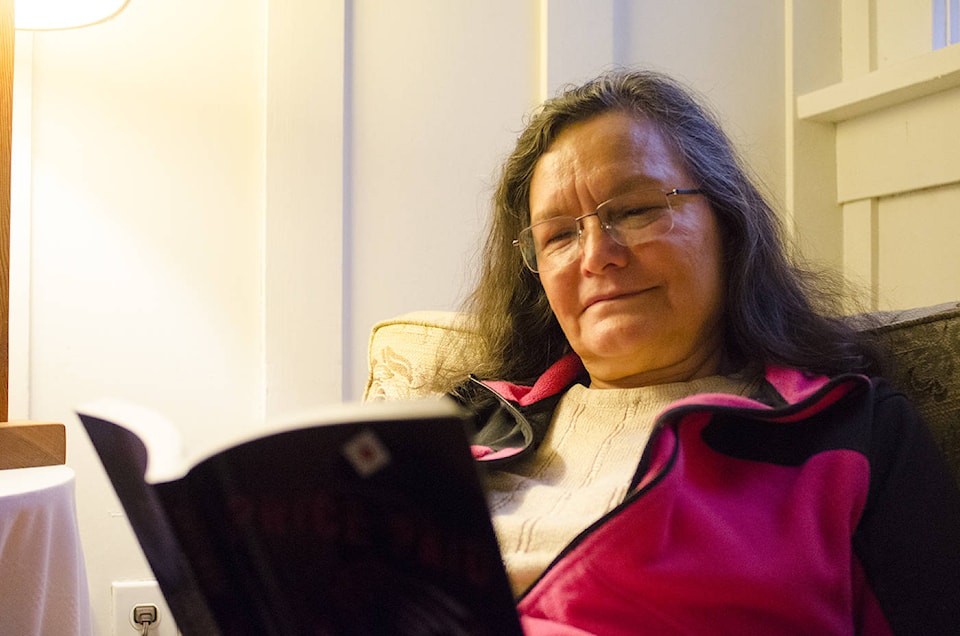It sounds a bit strange when someone on a prestigious writer-in-residency, currently working on their third and fourth books says they became a writer “accidentally.”
But when you’ve had a life like Bev Sellars has had, it makes sense.
“My first book,” Sellars says, “wasn’t even meant to be a book. I was just writing things down to try to connect my adult life with my childhood and all that had happened to me. I ended up with quite a folder full of notes and my husband Bill suggested that I turn it into a book.”
That book, They Called Me Number One, chronicles her life as a student at a residential school, breaking open that period of her life in a frank and heart-wrenching way.
The book follows her journey through substance abuse and suicide attempts to healing and understanding.
“I wanted my children, my nieces and my nephews to understand why there was so much dysfunction with their older relatives who had gone to residential school. That’s all it was going to be. I had a lot of bitter feelings toward my family for the things that happened to me, but when I started understanding myself – how all the things that happened to me as a child affected my adult life – I started looking at my family and those around me a lot differently.”
Part of what changed her mind about some very important truths, she says, was reading Under the Ribs of Death, by John Marlyn. The novel follows the life of a young Hungarian immigrant to Canada as he struggles to cast off his heritage to integrate into Canadian culture. It showed her that life isn’t necessarily all that rosy for those who came later to Canada, either.
“Before that I was always resentful of immigrants,” Sellars says. “To me, they came to our indigenous communities and just created chaos in our lives. They took the best part of everything and left us the bones. I didn’t have a vision of what other countries and people were like. I assumed – I was raised to believe – that white people were perfect. People find that silly, but when you have nothing to compare it to, it’s just what you believe.”
Sellars is in town as the current Haig-Brown Writer-in-Residence – the first indigenous person to be awarded the privilege.
And she hopes her work while she’s here can encourage others to tell their stories, as she has. She has plans to do various presentations for community organizations, get into the schools and work with local First Nations people to encourage them to write, too.
“There are so many stories that need to be told, and if I can do something to help bring those out, I’ll be happy to do that. Like I say, I would have never considered myself as a writer, but here I am working on my third and fourth books. Coming from where I did to having two books published, it really shows that anyone can do it.”
But storytelling isn’t about getting a book published.
“Our stories shouldn’t go to our graves with us. Whether they get published or not, they need to be told, even it’s just to our family.”
Ken Blackburn, chair of the Writer-in-Residence Selection committee as program coordinator for the Museum at Campbell River, says he’s overjoyed that the residency has finally been awarded to an indigenous person.
“She has an inspiring story to tell and there are so many people who could use hearing it,” he says, adding that they have been hoping for years that they’d get some applicants from more diverse backgrounds, but it has juet never panned out.
Every year, the residency puts out its call for writers and it goes through all of the usual networks, but we haven’t been getting any applications in from any First Nations populations – or even any of the other multicultural populations,” Blackburn says. “They’re just not applying. So the question is why? Is it because the message is going through channels they’re not participating in? Is it because there’s some kind of false understanding about what the residency is? Is it just residencies in general? I mean, not everybody can just up and go somewhere for five or six months.”
Besides her work in the local schools, mentoring local First Nations writers and presentations at local community organizations such as the North Island Transition Society, Sellars will also be having at least two public appearances.
The first of these, “An Afternoon With Bev Sellars” is coming up on Jan. 20 from 1 to 2:30 p.m. at the Museum at Campbell River. It is a meet-and-greet-style introduction to the community giving the public a chance to hear some of her amazing story and get to know her a little better.
The second, also at the museum, will be the presentation on which her second book, Price Paid, was based.
The presentation looks at Canadian History from an aboriginal perspective and takes place Feb. 17 from 1 to 4 p.m.
Admission to both events is by donation.
